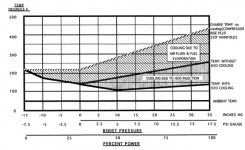T
Tinster
Guest
Guest
Offline
Just about 1 year ago Wendy gave me the Crypt
Car for Christmas. I noticed the temperature gauge
did not seem to function. The P.O. informed us
that was normal because Triumph engines usually
run very cold. Then the radiator immediately blew up.
Thus began the Crypt Car saga. Water temperature.
Crypty started this morning and I took him out
of the neighborhood. Yeah, I know- a truly foolhardy
thing to do but only 2 miles from home in case I had
to walk back)LOL
The new temp gauge usually sits at 180* when I am
on the street moving. I parked in the garage but
did not turn off the engine. Temp. zoomed up to
near 195*
So I got out my infrared pistol and shot the head
area around the water sensor unit=188*
Area beside the spark plugs=195*
Carbs=165*
Intake manifold= 170*
I ask this ?? and post the #temps because
the Crypt Car runs on and on after I turn off the
key. The MG mechanic said that is because my engine
is running too hot.
What are normal operating temperatures for a regular
TR6 1969? If mine are too high, how do I bring them down to normal ranges?
PS: The PO completely removed the heater system all
heater related pipes. Both pipes on the ends of my
intake manifold are capped off.
thanks,
d
Car for Christmas. I noticed the temperature gauge
did not seem to function. The P.O. informed us
that was normal because Triumph engines usually
run very cold. Then the radiator immediately blew up.
Thus began the Crypt Car saga. Water temperature.
Crypty started this morning and I took him out
of the neighborhood. Yeah, I know- a truly foolhardy
thing to do but only 2 miles from home in case I had
to walk back)LOL
The new temp gauge usually sits at 180* when I am
on the street moving. I parked in the garage but
did not turn off the engine. Temp. zoomed up to
near 195*
So I got out my infrared pistol and shot the head
area around the water sensor unit=188*
Area beside the spark plugs=195*
Carbs=165*
Intake manifold= 170*
I ask this ?? and post the #temps because
the Crypt Car runs on and on after I turn off the
key. The MG mechanic said that is because my engine
is running too hot.
What are normal operating temperatures for a regular
TR6 1969? If mine are too high, how do I bring them down to normal ranges?
PS: The PO completely removed the heater system all
heater related pipes. Both pipes on the ends of my
intake manifold are capped off.
thanks,
d

 Hi Guest!
Hi Guest!

 smilie in place of the real @
smilie in place of the real @
 Pretty Please - add it to our Events forum(s) and add to the calendar! >>
Pretty Please - add it to our Events forum(s) and add to the calendar! >> 

